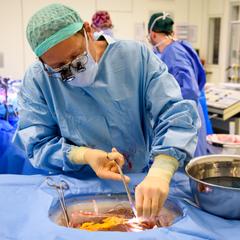Whereas in recent years an average of 75 liver transplants took place at UZ Leuven, in 2023 there were as many as 93. The increase is partly due to technological advances allowing doctors to use donor livers from people who died of cardiac arrest. By passing an oxygen-rich fluid through the liver via a perfusion machine, the livers suffer less damage and the recipient suffers fewer complications. Two thirds of the liver transplants of last year were done with a liver from someone who died after a cardiac arrest.
Livers donated after cardiac arrest are more likely to have complications than those donated after brain death. Therefore, livers from donors who died of cardiac arrest are less readily accepted by some transplant centres. The more time there is between removing the liver from the deceased and implanting it in the recipient, the more damage the organ suffers.
"We can now also give high-risk livers to high-risk recipients" prof. dr. Diethard Monbaliu
prof. dr. Diethard Monbaliu
UZ Leuven co-founded the development of a new perfusion machine technique that ensures that even 'difficult' livers can still serve for transplantation. The Dutch University Medical Centre Groningen recently created another world first by using the technique in question to allow donor livers to stay overnight, allowing a transplant to take place during the day. Unlike the Netherlands, there is no reimbursement for that technique yet in Belgium.
Of the 93 liver transplants at UZ Leuven in 2023, 63 were saved using the new perfusion machine. Of these, 61 livers were transplanted from deaths after cardiac arrest.
Reduced waiting list
Prof. dr. Diethard Monbaliu, transplant surgeon at UZ Leuven: "Livers from people who died after cardiac arrest are more likely to cause complications in a recipient. Until now, the only solution was to go into the operating theatre as soon as possible. Thanks to hopeful studies on the perfusion machine, we are more confident to transplant that type of 'difficult' livers anyway, even if several precious hours pass. Last but not least, we can now also give high-risk livers to high-risk recipients: patients who are in poor medical condition and who we used to think that a transplant would be too difficult for them or in whom the transplant is more difficult and takes longer. As a result, we will see a marked decrease in the waiting list for liver transplants by 2023."
These beautiful results are the work of quite a few UZ Leuven employees, with a special mention for the perfusionists: they are now also focusing specifically on organ perfusion.
IN FIGURES
- In Belgium and Eurotransplant, UZ Leuven is the largets transplant centre for livers of deceased donors (93 liver transplants in 2023) with very favourable results for the 1 and 5 year survival rate.
- In addition to the increased supply of high-risk livers (o.a. DCD donors of over 70 years) the conversion ratio also increased: the effectively transplanting the organ on offer. The ratio increased partly due to standard implementation of the perfusion technique DHOPE: 59% in 2022 to 82% in 2023.
- Evolution of the number of liver transplants at UZ Leuven
2023: 93
2022: 69
2021: 78
2020: 61
2019: 76
2018: 75